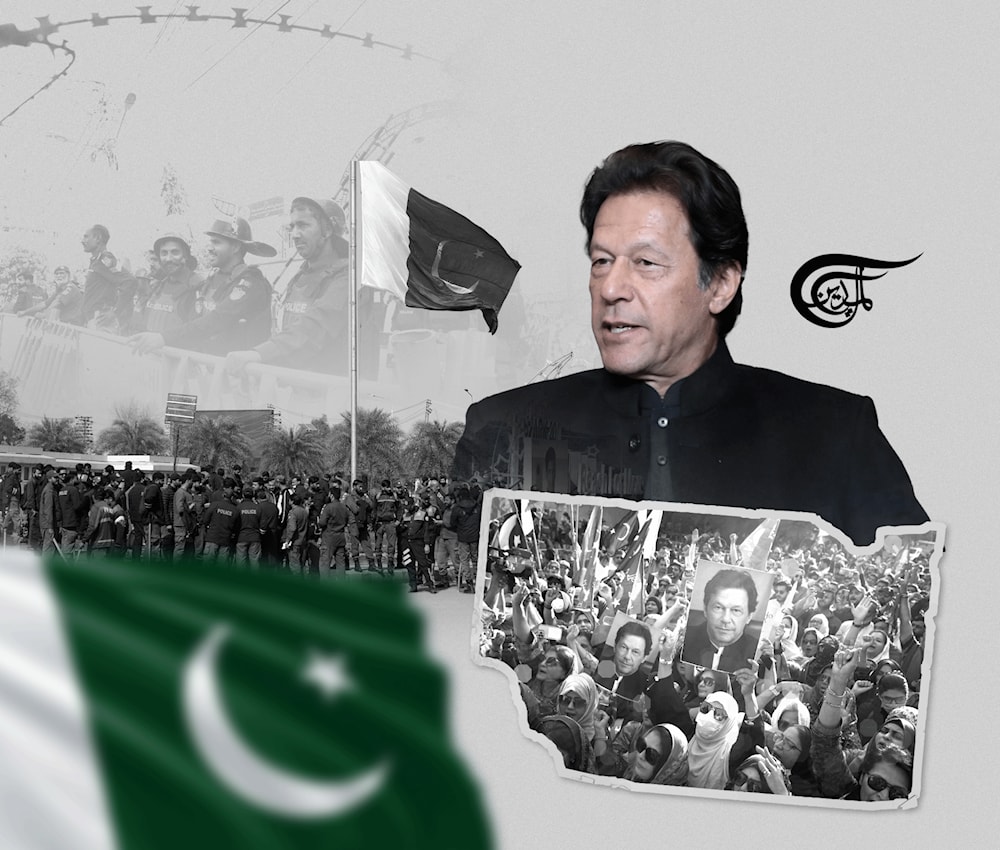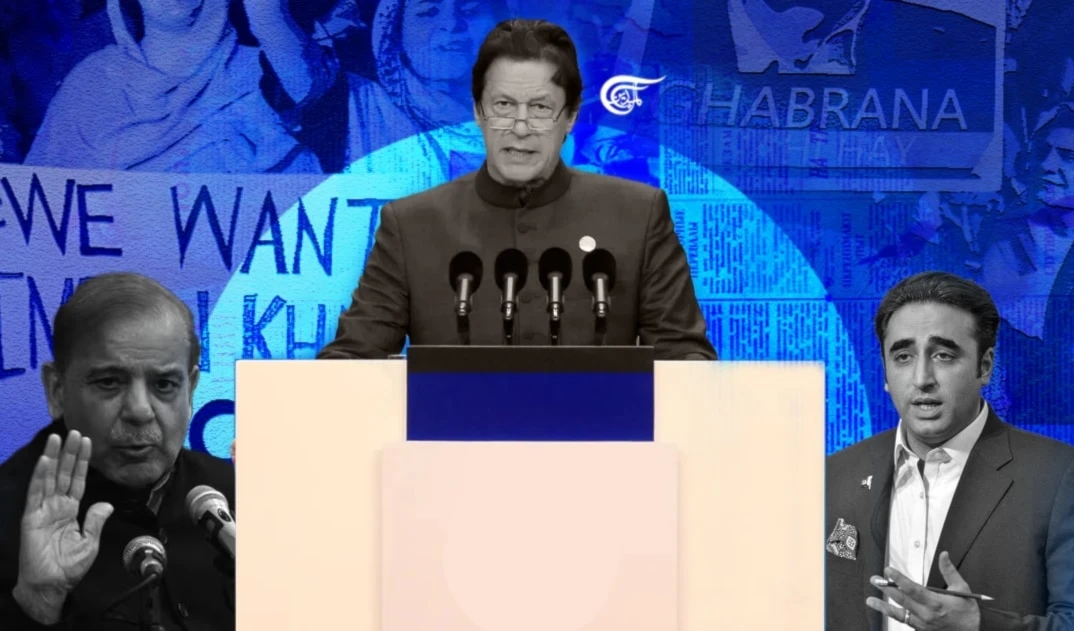What’s next for Pakistan after February 2024?
The election results indicate that no single party secured a majority amid alliances being forged and candidates being wooed to form a government.
-

Complaints of election rigging and fraud has also questioned the credibility of the Election Commission of Pakistan which continues to maintain that despite a few isolated irregularities (Illustrated by Mahdi Rteil to Al Mayadeen English)
Pakistan’s election results after the February 2024 election indicate a clear victory for Pakistan Tehreek I Insaaf backed Independents. Victory cries from Pakistan Muslim League N’s supremo Nawaz Sharif cannot detract from an undeniable reality that the PML N does not have enough seats in the National Assembly. The results, although disputed, can also not deny the fact that despite a plethora of cases being imposed on him, former Prime Minister Imran Khan has emerged as the most popular leader in Pakistan. His status of being incarcerated has elevated him as Pakistan’s future Prime Minister in the eyes of the average voter, where the PTI’s brawl with the powerful establishment was not enough to undercut his influence among Pakistanis. Still, the Imran wave cannot refute how Pakistan faces a perpetual state of instability as lack of government formation, bitter rivalries and lingering disputes raises the million-dollar question on what’s next.
The election results indicate that no single party secured a majority amid alliances being forged and candidates being wooed to form a government. The results are instead indicative of where Pakistan stands as the country continues to be polarized on partisan lines and the economy nosedives further amid rising sovereign debt, a teetering IMF bailout program, and soaring inflation. The frustration of the average voter is equally palpable given that the mainstream media continues to expose politicians rushing into polling stations, busting ballot boxes, and in essence, overturning the public’s mandate which is favor of Khan.
Yet this was not unexpected and is also internationally endorsed. Widespread claims of rigging, fraud, and tinkering with results have emerged across the country. The mishandling has prompted some political leaders to resign over moral grounds. The Jamaat-I-Islami’s key figurehead from Karachi, Hafiz Naeem Ur Rehman for example, resigned from his Sindh Assembly seat claiming that it was rigged in his favor as the actual claimant is a candidate belonging to the PTI-backed Independents. Similarly, allegations of fraud in Form 45 (which counts the results), and manipulation of results in form 47 (which contains the number of rejected votes), has spurred the Tehreek I Insaaf into motion. From Adiala Jail, PTI Chairman Imran Khan called for nationwide protests against electoral rigging which follows similar protests in the city of Peshawar. Separately, differences emerged within the PML N over stalwart Nawaz Sharif’s decision to announce the candidature of his brother Shehbaz Sharif for Prime Minister and his daughter Maryam Nawaz as Chief Minister of Punjab instead of himself. This comes as the PML N scrambles to get allies on board including Independents (PTI backed and otherwise) to form a federal government in Islamabad.
Complaints of election rigging and fraud has also questioned the credibility of the Election Commission of Pakistan which continues to maintain that despite a few isolated irregularities, the election results are on merit. That is not the view of international observers however. If one goes simply by numbers, then PTI-backed candidates have secured the most seats in the National Assembly with 93 and deserve a lot more. The party’s member and prominent Lawyer Salman Akram Raja for example, moved the Islamabad High Court against the Istekham E Pakistan Party’s candidate, Aun Chaudhary over a notification of his victory in the NA 128 constituency in Lahore which was clearly rigged. Raja and his election agents were forcibly evicted from the premises where the consolidation of the results received from 433 polling stations was being carried out. Such blatant violations of the law are preventing PTI-backed Independents from emerging with a greater number of seats at the expense of other parties.
The PTI protests after rigging became apparent, and the fear of a statewide crackdown against its activists, candidates and leadership is once again resulting in a perpetual state of uncertainty for Pakistan. Given that Islamabad does not have a government and political parties barring a few traditional ones, are refusing to forge alliances over power-sharing arrangements, (claims of unfair practices or a combination of both), there is little respite for the common man. PTI-backed independents have also suffered their own blows as the right-wing Jamaat-I-Islami refused to forge an alliance with them in the Khyber Pakhtunkhwa province, where the former has emerged as the largest party in the provincial assembly polls. Similarly, the party has had to rely on the Majlis Wahdat-e-Muslimeen, a Shia political organization for its reserved seats and a party platform as the Election Commission of Pakistan had previously stripped it off of its electoral symbol.
PTI protests, albeit legitimate, is plunging Pakistan into further political turmoil. These realities are preventing the only Muslim country with nuclear weapons to rid itself from the shackles of clientele politics, economic meltdowns, and further insecurity. In essence, the ruling elite which includes the traditional guard of the PML N is preventing and in many ways hijacking, the public mandate of the Pakistani voter due to narrow, parochial interests. This defiance is resulting in a staggered transition to the next democratically elected government which faces an uphill task in ameliorating issues such as unemployment, rising inflation, population growth, energy shortages and a crippling infrastructure. The manifestoes of the parties in the lead up to the election were also eerily similar to previous promises which has contributed to their declining vote bank as most voters remain dissatisfied with the status quo.
In the absence of a government, bitter rivalries and a divided society, Pakistan is bracing for further political uncertainty. The results are in favor of the PTI, but polarization remains widespread.

 Hamzah Rifaat
Hamzah Rifaat
 6 Min Read
6 Min Read











